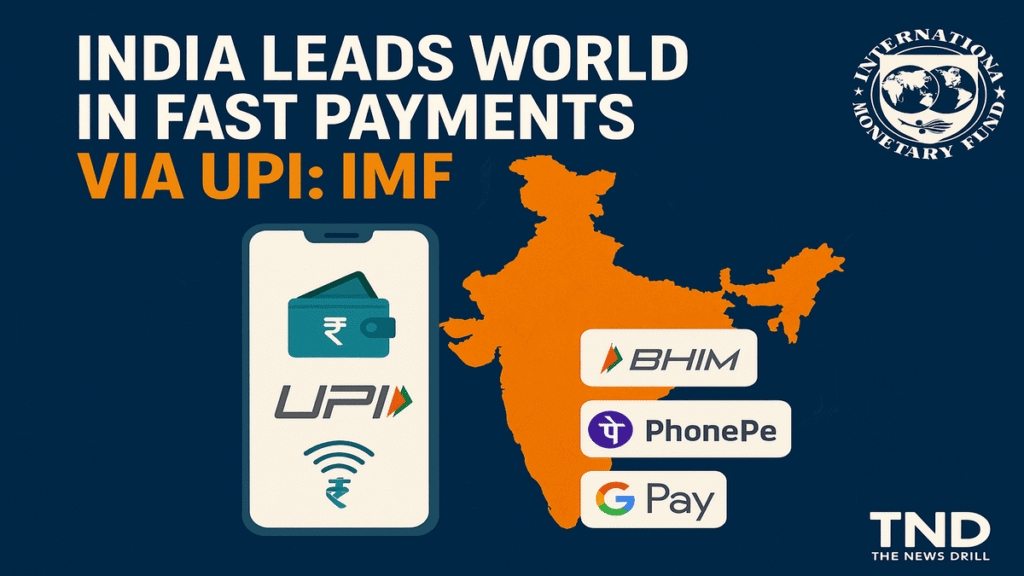
India Leads the World in Fast Payments with Unified Payments Interface: IMF Lauds UPI Revolution.
In a significant endorsement of India’s digital transformation journey, the International Monetary Fund (IMF) has recognized India’s Unified Payments Interface (UPI) as a global benchmark for fast and inclusive digital payments. According to the IMF’s latest report, India now leads the world in fast payment systems, thanks largely to the exponential rise of UPI adoption across urban and rural regions alike.
The Unified Payments Interface has not only redefined how Indians pay and transact but also set a compelling precedent for other countries aiming to modernize their payment infrastructures. With real time, 24/7 functionality and zero transaction charges for most users, UPI in India has become a game changer in the fintech space.
What is Unified Payments Interface (UPI)?
Launched by the National Payments Corporation of India (NPCI) in 2016, the Unified Payments Interface is a real time payment system that allows users to link multiple bank accounts into a single mobile application. This system facilitates instant money transfers, bill payments, merchant transactions, and more all with just a mobile number or Virtual Payment Address (VPA).
Unlike traditional online transfers, UPI eliminates the need to enter bank details like IFSC codes, thus reducing friction in digital payments. Its core features include:
- Instant peer to peer (P2P) transfers
- Seamless merchant payments
- QR-code scanning for physical transactions
- Support for overdraft accounts, IPO subscriptions, and recurring mandates
Explosive Growth of UPI in India
In less than a decade, Unified Payments Interface has become the backbone of India’s digital economy. The following statistics from NPCI highlight the scale of its growth:
- Over 13 billion UPI transactions were recorded in June 2025 alone.
- Total transaction value surpassed ₹20 lakh crore in a single month.
- More than 300 million users actively use UPI monthly.
- UPI is accepted at over 300 million merchants, including street vendors.
According to the IMF, no other country has achieved such extensive reach and integration of a public digital payment platform in such a short time.
Why UPI is a Global Benchmark
The IMF’s Working Paper published in July 2025 notes several reasons why Unified Payments Interface stands out globally:
1. Public Infrastructure Model:
Unlike most countries where fast payment systems are operated by private banks or fintechs, UPI is a government backed public utility. NPCI, a not for profit organization, ensures that UPI operates on principles of accessibility and neutrality.
2. Interoperability
UPI allows interoperability between banks and wallet apps like PhonePe, Google Pay, Paytm, and BHIM. This breaks the monopoly of closed loop systems, encouraging healthy competition and financial inclusion.
3. Cost Efficiency
Transactions on the Unified Payments Interface are largely free for end users. This makes digital payments viable for even the smallest merchants and consumers, particularly in Tier 2 and Tier 3 cities.
4. Open API Framework
UPI’s open architecture has encouraged fintech innovation. Over 100 startups have launched UPI based services in lending, credit scoring, and digital commerce.
International Interest in UPI Model
India’s success with the Unified Payments Interface has inspired countries like France, Singapore, UAE, Bhutan, and Nepal to integrate UPI or launch UPI style systems.
In 2023, India and Singapore launched PayNow-UPI linkage, enabling real time cross border payments. France followed with the UPI–Lyra Connect, allowing Indian tourists to pay in rupees at French merchants.
The IMF suggests that India could play a key role in setting global digital payment standards via UPI based diplomacy and partnerships through G20, IMF, and World Bank platforms.
UPI and Financial Inclusion
Perhaps the most transformative aspect of the Unified Payments Interface is its role in democratizing access to digital payments. The platform has become an essential tool for:
- Farmers receiving DBT (Direct Benefit Transfers)
- Daily wage workers transacting with ease
- Small vendors and hawkers using QR codes to accept payments
- Women in rural areas managing their accounts through feature rich apps
The IMF report praises India for integrating UPI into Jan Dhan accounts, Aadhaar, and mobile number linkage, known as the JAM Trinity, creating a frictionless pipeline for financial empowerment.
Role of Indian Fintech Startups
India’s fintech boom owes much of its success to the Unified Payments Interface. From unicorns like PhonePe and Paytm to emerging players like Slice, Jupiter, and BharatPe, startups have leveraged UPI to build innovative offerings.
For example:
- PhonePe leads with over 48% UPI market share
- Cred uses UPI for credit card bill payments
- Navi and Simpl provide micro credit services using UPI data
This synergy between public infrastructure and private innovation is what the IMF highlights as India’s unique fintech model.
Security and Privacy in UPI
Security has remained a top concern for any digital payments system. The Unified Payments Interface has robust mechanisms like:
- Two-factor authentication
- Real time fraud detection
- Tokenized transactions
- UPI Lite for small value offline payments
The Reserve Bank of India (RBI) and NPCI continue to update guidelines to protect users and prevent misuse. In 2024, the UPI Fraud Monitoring Dashboard was launched, helping banks and platforms proactively tackle malicious activity.
What’s Next for UPI?
With the UPI ecosystem continuing to expand, here’s what the future holds:
- UPI Lite+: Offline UPI with dynamic QR codes for feature phones.
- UPI Credit Line: RBI’s 2025 guidelines allow banks to offer credit via UPI, enabling instant loans.
- Global UPI acceptance: Partnerships with more countries are in the pipeline, including UK, USA, Japan, and Sri Lanka.
- Voice-enabled UPI: NPCI is testing AI-driven voice commands for payments in multiple Indian languages.
- UPI for IPOs and Mutual Funds: Retail investors can now subscribe to IPOs and SIPs using UPI linked apps.
Conclusion
The IMF’s recognition of India as the global leader in fast payments is not just a financial milestone it is a validation of India’s vision to build digital public infrastructure that empowers its citizens. The Unified Payments Interface has transformed India from a cash dependent economy to a leader in digital finance.
By creating a secure, inclusive, and scalable platform, India has not only addressed its own challenges but also shown the world how technology can bridge economic and social divides.
As UPI enters its next phase of global expansion and product diversification, it reinforces one fundamental idea: technology in the public interest can transform lives not just in metros, but in the most remote villages of India.
Key Takeaways
- India leads the world in fast payments according to IMF, driven by UPI.
- Unified Payments Interface enables over 13 billion monthly transactions.
- UPI supports real time, interoperable, zero-cost digital payments.
- Fintechs and startups have built revolutionary apps using UPI’s infrastructure.
- IMF recommends UPI as a model for other developing nations.The future includes voice payments, UPI Lite+, international expansion, and credit on UPI.
Stay Connected with The News Drill for more updates. Stay informed. Stay updated. Stay Ahead.
Have insights or stories related to Unified Payments Interface and digital payments in India?📧 Email us at: editor@thenewsdrill.com📰 Send tips or submissions: The News Drill Contributor Page
Contact us: contact@thenewsdrill.com



